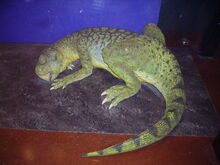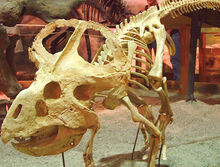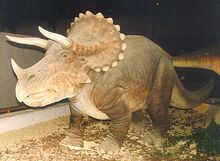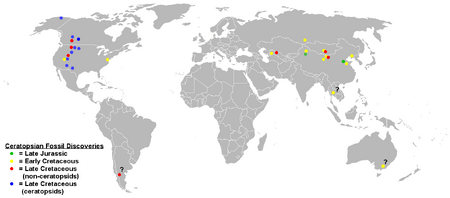| iCeratopsians
| ||||||||||||||
|---|---|---|---|---|---|---|---|---|---|---|---|---|---|---|
 Triceratops skull
| ||||||||||||||
|
Extinct (fossil)
| ||||||||||||||
| Scientific classification | ||||||||||||||
| ||||||||||||||
|
Ceratopsia (Greek: "horned faces") is a group of herbivorous, beaked dinosaurs which thrived in what are now North America and Asia, during the Cretaceous Period, although ancestral forms lived earlier, in the Jurassic. Early members such as Psittacosaurus were small and bipedal. Later members, including ceratopsids like Centrosaurus and Triceratops, became very large quadrupeds and developed elaborate facial horns and a neck frill. While the frill might have served to protect the vulnerable neck from predators, it may also have been used for display, thermoregulation, or some combination of the above. Ceratopsians ranged in size from 1 meter (3 feet) and 23 kilograms (50 pounds) to over 9 m (30 ft) and 5,400 kg (6 short tons).
Triceratops is by far the best-known ceratopsian to the general public. It is traditional for ceratopsian genus names to end in "-ceratops", although this is not always the case. One of the first named genera was Ceratops itself, which lent its name to the group, although it is considered a nomen dubium today as it has no distinguishing characteristics that are not also found in other ceratopsians.[1]
Anatomy
Ceratopsians are easily recognized by features of the skull. On the tip of a ceratopsian upper jaw is the rostral bone, a unique bone found nowhere else in the animal kingdom. Along with the predentary bone, which forms the tip of the lower jaw in all ornithischians, the rostral forms a superficially parrot-like beak. Also, the jugal bones below the eye are very tall and flare out sideways, making the skull appear somewhat triangular when viewed from above. This triangular appearance is accentuated, in later ceratopsians, by the rearwards extension of the parietal and squamosal bones of the skull roof, to form the neck frill.[2][3]
Taxonomy
Ceratopsia was coined by Othniel Charles Marsh in 1890 to include animals related to Ceratops. The name is derived from the Greek κερας/keras meaning 'horn' and οψις/opsis meaning 'face'.[4] As early as the 1960s, it was noted that the name Ceratopsia is actually incorrect linguistically and that it should be Ceratopia.[5] However, this spelling, while technically correct, has been used only rarely in the scientific literature and the vast majority of paleontologists continue to use Ceratopsia. As the ICZN does not govern taxa above the level of superfamily, this is unlikely to change.

An early ceratopsian: Psittacosaurus life restoration from the Natural History Museum, London.

A typical protoceratopsid: Protoceratops skeleton at the Wyoming Dinosaur Center.

A derived ceratopsid: Triceratops model at the Royal Belgian Institute of Natural Sciences
In rank-based Linnaean taxonomy, Ceratopsia is usually considered an infraorder within the suborder Marginocephalia, which also includes pachycephalosaurids. In clade-based phylogenetic taxonomy, Ceratopsia is often defined to include all marginocephalians more closely related to Triceratops than to Pachycephalosaurus.[6] The most basal known ceratopsians are Yinlong, from the Late Jurassic Period, along with Chaoyangsaurus and the family Psittacosauridae, from the Early Cretaceous Period, all of which were discovered in northern China or Mongolia. The rostral bone and flared jugals are already present in all of these forms, indicating that even earlier ceratopsians remain to be discovered.
Neoceratopsia includes all ceratopsians more derived than psittacosaurids. Another subset of neoceratopsians is called Coronosauria, which currently includes all ceratopsians more derived than Auroraceratops. Coronosaurs show the first development of the neck frill and the fusion of the first several neck vertebrae to support the increasingly heavy head. Within Coronosauria, three groups are generally recognized, although the membership of these groups varies somewhat from study to study and some animals may not fit in any of them. One group can be called Protoceratopsidae and includes Protoceratops and its closest relatives, all Asian. Another group, Leptoceratopsidae, includes mostly North American animals that are more closely related to Leptoceratops. The Ceratopsoidea includes animals like Zuniceratops which are more closely related to the family Ceratopsidae. This last family includes Triceratops and all the large North American ceratopsians and is further divided into the subfamilies Centrosaurinae and Ceratopsinae (also known as Chasmosaurinae).
Classification
Following is a list of ceratopsian genera by classification and location:
- Infraorder Ceratopsia
- Yinlong - (Xinjiang, western China)
- Family Chaoyangsauridae
- Xuanhuaceratops - (Hebei, China)
- Chaoyangsaurus - (Liaoning, northeastern China)
- Family Psittacosauridae
- Psittacosaurus - (China & Mongolia)
- Hongshanosaurus - (Liaoning, northeastern China)
- Liaoceratops - (Liaoning, northeastern China)
- Yamaceratops - (Mongolia)
- Archaeoceratops - (Gansu, northwestern China)
- Auroraceratops - (Gansu, northwestern China)
- Family Leptoceratopsidae
- Bainoceratops - (Mongolia)
- Leptoceratops - (Alberta, Canada & Wyoming, USA)
- Montanoceratops - (Montana, USA)
- Prenoceratops - (Montana, USA)
- Udanoceratops - (Mongolia)
- Family Protoceratopsidae
- Graciliceratops - (Mongolia)
- Bagaceratops - (Mongolia)
- Breviceratops - (Mongolia)
- Lamaceratops - (Mongolia)
- Magnirostris - (Inner Mongolia, China)
- Platyceratops - (Mongolia)
- Protoceratops - (Mongolia)
- Superfamily Ceratopsoidea
- Zuniceratops - (New Mexico, USA)
- Family Ceratopsidae
There are several fragmentary Asian forms which may or may not be valid: Asiaceratops, Kulceratops, Microceratops, and Turanoceratops. Possible ceratopsians from the Southern Hemisphere include the Australian Serendipaceratops, known from an ulna, and Notoceratops from Argentina is known from a single toothless jaw (which has been lost).[7]
Phylogeny
Paleontologists today agree on the overall structure of the ceratopsian family tree, although there are differences on individual taxa. There have been several cladistic studies performed on basal ceratopsians since 2000. None have used every taxon listed above and many of the differences between the studies are still unresolved.
Xu/Makovicky/Chinnery
Xu Xing of the Chinese Institute of Vertebrate Paleontology and Paleoanthropology (IVPP) in Beijing, along with Peter Makovicky, formerly of the American Museum of Natural History (AMNH) in New York City and others, published a cladistic analysis in the 2002 description of Liaoceratops.[8] This analysis is very similar to one published by Makovicky in 2001.[9] Makovicky, who currently works at the Field Museum of Natural History in Chicago, also included this analysis in his 2002 doctoral thesis. Xu and other colleagues added Yinlong to this analysis in 2006.[10]
Brenda Chinnery, formerly of the Museum of the Rockies in Bozeman, Montana, independently described Prenoceratops in 2005 and published a new phylogeny.[11] In 2006, Makovicky and Mark Norell of the AMNH incorporated Chinnery's analysis into their own and also added Yamaceratops, although they were not able to include Yinlong.[12] The cladogram presented below is a combination of Xu, Makovicky, and their colleagues' most recent work.
CERATOPSIA
\--Yinlong
\--*--Chaoyangsaurus
\ *--IVPP V12722
\--PSITTACOSAURIDAE
NEOCERATOPSIA
\--Liaoceratops
\--Yamaceratops
\--Archaeoceratops
CORONOSAURIA
\----LEPTOCERATOPSIDAE
\ \--Montanoceratops
\ \ /--Udanoceratops
\ *--+---Leptoceratops
\ \--Prenoceratops
\--Graciliceratops
\----PROTOCERATOPSIDAE
\ *--Bagaceratops
\ *--Protoceratops
\--Zuniceratops
CERATOPSIDAE
Chaoyangsaurus is recovered in a more basal position than Psittacosauridae, although Chinnery's original analysis finds it within Neoceratopsia. Protoceratopsidae is considered to be the sister group of Ceratopsoidea. The fragmentary Asiaceratops was included in these studies and is found to have a variable position, either as a basal neoceratopsian or as a leptoceratopsid, most likely due to the amount of missing information. Removal of Asiaceratops stabilizes the entire cladogram.
Makovicky's latest analysis includes IVPP V12722 ("Xuanhuasaurus"), an undescribed Late Jurassic ceratopsian from China that is still awaiting publication. Kulceratops and Turanoceratops are considered nomina dubia in this study. Makovicky believes Lamaceratops, Magnirostris, and Platyceratops to be junior synonyms of Bagaceratops, and Bainoceratops to be synonymous with Protoceratops.
You/Dodson
You Hailu of Beijing's Chinese Academy of Geological Sciences, was a co-author with Xu and Makovicky in 2002 but, in 2003, he and Peter Dodson from the University of Pennsylvania published a separate analysis.[13] The two presented this analysis again in 2004.[2] In 2005, You and three others, including Dodson, published on Auroraceratops and inserted this new dinosaur into their phylogeny.[14]
CERATOPSIA
\--PSITTACOSAURIDAE
NEOCERATOPSIA
\--Chaoyangsaurus
\--Liaoceratops
\--Archaeoceratops
\--Auroraceratops
CORONOSAURIA
\----PROTOCERATOPSIDAE
\ *--Bagaceratops
\ *--Protoceratops
\----LEPTOCERATOPSIDAE
\ *--Leptoceratops
\ *--Montanoceratops
CERATOPSIDAE
In contrast to the previous analysis, You and Dodson find Chaoyangsaurus to be the most basal neoceratopsian, more derived than Psittacosaurus, while Leptoceratopsidae, not Protoceratopsidae, is recovered as the sister group of Ceratopsidae. This study includes Auroraceratops but lacks seven taxa found in Xu and Makovicky's work, so it is unclear how comparable the two studies are. Asiaceratops and Turanoceratops are each considered nomen dubium and not included. Along with Dong Zhiming, You described Magnirostris in 2003, but to date has not included it any of his cladograms.[15]
Paleobiology
Biogeography

Ceratopsian fossil discoveries. The presence of Jurassic ceratopsians only in Asia indicates an Asian origin for the group, while the more derived ceratopsids occur only in North America. Questionable remains are indicated with question marks.
Ceratopsia appears to have originated in Asia, as all of the earliest members are found there. Fragmentary remains, including teeth, which appear to be neoceratopsian, are found in North America from the Albian stage (112 to 100 million years ago), indicating that the group had dispersed across what is now the Bering Strait by the middle of the Cretaceous Period.[16] Almost all leptoceratopsids are North American, aside from Udanoceratops, which may represent a separate dispersal event, back into Asia. Ceratopsids and their immediate ancestors, such as Zuniceratops, are not found in Asia or any other continent and appear to be endemic to western North America.[2][11] However, if Notoceratops and Serendipaceratops are indeed ceratopsians, this hypothesis will be significantly affected.
Individual variation
Unlike almost all other dinosaur groups, skulls are the most commonly preserved elements of ceratopsian skeletons and many species are known only from skulls. There is a great deal of variation between and even within ceratopsian species. Complete growth series from embryo to adult are known for Psittacosaurus and Protoceratops, allowing the study of ontogenetic variation in these species.[17][18] Significant sexual dimorphism has been noted in Protoceratops and several ceratopsids.[2][3][19]
Ecological role
Psittacosaurus and Protoceratops are the most common dinosaurs in the different Mongolian sediments where they are found. Triceratops fossils are far and away the most common dinosaur remains found in the latest Cretaceous rocks in the western United States (up to 70% of the fauna in some areas). These facts appear to indicate that some ceratopsians were the dominant herbivores in their environments.
Many species of ceratopsians appear to have been gregarious, living in herds. Several North American bonebed deposits indicate that some species may have lived in herds of thousands of animals. Like modern migratory herds, they would have had a significant effect on their environment, as well as serving as a major food source for predators.
References
- ↑ Dodson, P. 1996. The Horned Dinosaurs. Princeton: Princeton University Press. 346pp.
- ↑ 2.0 2.1 2.2 2.3 You H. & Dodson, P. 2004. Basal Ceratopsia. In: Weishampel, D.B., Dodson, P., & Osmolska, H. (Eds.). The Dinosauria (2nd Edition). Berkeley: University of California Press. Pp. 478-493.
- ↑ 3.0 3.1 Dodson, P., Forster, C.A., & Sampson, S.D. 2004. Ceratopsidae. In: Dodson, P., Weishampel, D.B., & Osmolska, H. (Eds.). The Dinosauria (2nd Edition). Berkeley: University of California Press. Pp. 494-513.
- ↑ Marsh, O.C. 1890. Additional characters of the Ceratopsidae, with notice of new Cretaceous dinosaurs. American Journal of Science. 39: 418-429.
- ↑ Steel, R. 1969. Ornithischia. In: Kuhn, O. (Ed.). Handbuch de Paleoherpetologie (Part 15). Stuttgart: Gustav Fischer Verlag. 87pp.
- ↑ Sereno, P.C. 1998. A rationale for phylogenetic definitions, with applications to the higher-level taxonomy of Dinosauria. Neues Jahrbuch fur Geologie und Palaontologie: Abhandlungen 210: 41-83.
- ↑ Rich, T.H. & Vickers-Rich, P. 2003. Protoceratopsian? ulnae from the Early Cretaceous of Australia. Records of the Queen Victoria Museum. No. 113.
- ↑ Xu X., Makovicky, P.J., Wang X., Norell, M.A., You H. 2002. A ceratopsian dinosaur from China and the early evolution of Ceratopsia. Nature 416: 314-317.
- ↑ Makovicky, P.J. 2001. A Montanoceratops cerorhynchus (Dinosauria: Ceratopsia) braincase from the Horseshoe Canyon Formation of Alberta, In: Tanke, D.H. & Carpenter, K. (Eds.). Mesozoic Vertebrate Life. Bloomington: Indiana University Press. Pp. 243-262.
- ↑ Xu X., Forster, C.A., Clark, J.M., & Mo J. 2006. A basal ceratopsian with transitional features from the Late Jurassic of northwestern China. Proceedings of the Royal Society B: Biological Sciences. 273: 2135-2140
- ↑ 11.0 11.1 Chinnery, B. 2005. Description of Prenoceratops pieganensis gen. et sp. nov. (Dinosauria: Neoceratopsia) from the Two Medicine Formation of Montana. Journal of Vertebrate Paleontology 24(3): 572–590.
- ↑ Makovicky, P.J. & Norell, M.A. 2006. Yamaceratops dorngobiensis, a new primitive ceratopsian (Dinosauria: Ornithischia) from the Cretaceous of Mongolia. American Museum Novitates 3530: 1-42.
- ↑ You H. & Dodson, P. 2003. Redescription of neoceratopsian dinosaur Archaeoceratops and early evolution of Neoceratopsia. Acta Palaeontologica Polonica 48(2): 261–272.
- ↑ You H., Li D., Lamanna, M.C., & Dodson, P. 2005. On a new genus of basal neoceratopsian dinosaur from the Early Cretaceous of Gansu Province, China. Acta Geologica Sinica (English edition) 79(5): 593-597.
- ↑ You H. & Dong Z. 2003. A new protoceratopsid (Dinosauria: Neoceratopsia) from the Late Cretaceous of Inner Mongolia, China. Acta Geologica Sinica (English edition). 77(3): 299-303.
- ↑ Chinnery, B.J., Lipka, T.R., Kirkland, J.I., Parrish, J.M., & Brett-Surman, M.K. 1998. Neoceratopsian teeth from the Lower to Middle Cretaceous of North America. In: Lucas, S.G., Kirkland, J.I., & Estep, J.W. (Eds.). Lower and Middle Cretaceous Terrestrial Ecosystems. New Mexico Museum of Natural History and Science Bulletin 14: 297-302.
- ↑ Erickson, G.M. & Tumanova, T.A. 2000. Growth curve of Psittacosaurus mongoliensis Osborn (Ceratopsia: Psittacosauridae) inferred from long bone histology. Zoological Journal of the Linnean Society of London 130: 551-566.
- ↑ Dodson, P. 1976. Quantitative aspects of relative growth and sexual dimorphism in Protoceratops. Journal of Paleontology 50: 929-940.
- ↑ Lehman, T.M. 1990. The ceratopsian subfamily Chasmosaurinae: sexual dimorphism and systematics. In: Carpenter, K. & Currie, P.J. (Eds.). Dinosaur Systematics: Approaches and Perspectives. Cambridge: Cambridge University Press. Pp. 211-230.

|
This page uses content from Wikipedia. The original article was at Ceratopsia. The list of authors can be seen in the page history. As with Paleontology Wiki, the text of Wikipedia is available under the GNU Free Documentation License. |